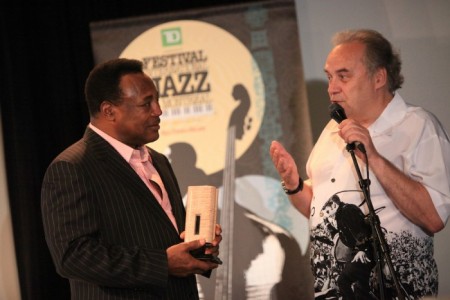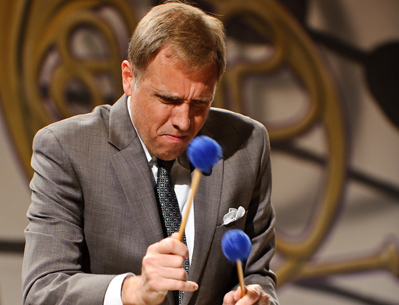Dec 9, 2025 12:28 PM
In Memoriam: Gordon Goodwin, 1954–2025
Gordon Goodwin, an award-winning saxophonist, pianist, bandleader, composer and arranger, died Dec. 8 in Los Angeles.…

George Benson (left) accepts an award from André Ménard in 2010.
(Photo: ©Festival International de Jazz de Montréal, Frédérique Ménard-Aubin)A big part of the hang was the late-night jam sessions. Whereas many festival jam sessions fail to bring out the headliners and heavy hitters, Douglas said FIJM was different.
“I remember very well getting my ass kicked—deservedly—by Jeff Watts at the jam session. Also, I remember meeting Phineas Newborn at that same session. One-of-a-kind life lessons. That session used to be a big forum for ideas.”
Among Canadian musicians, FIJM also became known as an event that can kickstart a career.
Bassist Chris Tarry was a young bandleader based in Vancouver when he played at FIJM in 1995 as part of a competition for Canadian artists.
“I remember if you won, you got a record deal,” said Tarry, who now lives in the New York area. “That was the biggest thing that had happened to me up to that point, and I remember flying to Montreal for the gig and thinking I’d made the big time. So, there’s a general ‘largeness’ to a gig at the Montreal festival, which was pretty intoxicating as a young musician.”
More than just being big, FIJM also set itself apart by cannily showcasing artists whose careers were about to explode, such as Norah Jones, who played a festival gig just after her 2002 Blue Note Records debut, Come Away With Me, was released, and who returns to headline the festival this year. Featuring non-jazz acts like Public Enemy, Prince and Patti Smith, and landing deals like the one that led to Miles Davis’ artwork being featured on a FIJM poster, also became hallmarks of the event.
Despite keeping its focus squarely on popular artists, the festival has not shied away from avant-garde sounds, such as a memorable 2010 concert by Lou Reed, Laurie Anderson and John Zorn that amazed some fans, but drove many attendees from their seats.
Above all, FIJM always has been definitively of Montreal. Even with a string of international corporate sponsors, ranging from Rio Tinto to General Motors, the festival has maintained its close ties to the city. That relationship has proven essential in gaining the level of cooperation that makes closing down a huge piece of the urban core possible for 10 days and led the city to create a permanent Festival Plaza in 2009.
“Sometimes the scale of big festivals can make one feel a little unnoticed,” Tarry said, “but FIJM has seemed to sidestep this. For whatever reason, I always felt appreciated by the festival, whenever I had the pleasure of playing there.”
Douglas, who participated in an 80th birthday celebration for Wayne Shorter in 2013, said FIJM has distinguished itself by honoring the jazz elders.
“Being able to celebrate our masters brings such warmth and satisfaction,” he said. “It’s an important thing to recognize leaders and living masters, and to acknowledge that the music always goes on, long into the future.”
“I’ve always felt like I belonged to a very privileged group of people that could make a living and enjoy being in the company of great musicians,” Ménard said. “I thought it was wonderful to be involved, to be in some kind of relationship with the artist. But, as much as I’m fascinated by the magic of what they can do, I’m still very intimidated by it, too.”
A voracious musical appetite helps Ménard retain his youthful enthusiasm throughout the year. “I’m still on the street every night, like when I was 16,” he said. “I go see two, three things almost every night of the week because I’m still interested in it, and there’s so much diversity.”
Ménard has seen his city go from being known by the non-French-speaking part of the world primarily for hockey and its European vibe to being recognized as the home of Arcade Fire, Cirque du Soleil and countless other culture-shaping artists. While he dodges opportunities to trumpet FIJM’s role in changing perceptions, he acknowledged the recognition of what he and Simard have accomplished.
“We get requests from many festivals to learn how we’ve been so successful and copy our formula,” Ménard said. “I tell them, ‘It’s very simple. There’s no secret. You need the kind of city that supports you. You need the kind of people who want to go to see what you put on, and you need this great, concentrated inventory of venues that vary in size that Montreal has.’ We had all those things and we survived. We never went bankrupt. We always paid our bills. I’m pretty proud of that.”
Ménard shrugged off any notion that FIJM’s programming will change radically after his retirement. In recent years, he has begun to share much of the curating and booking duties with colleagues. Gesturing around his office at stacks of recordings, Ménard said he looks forward to having more time to listen to music.
“If I have more time to enjoy the music—ah—to me, records are as many windows on the world.”
Ménard has never tired of looking. DB

Goodwin was one of the most acclaimed, successful and influential jazz musicians of his generation.
Dec 9, 2025 12:28 PM
Gordon Goodwin, an award-winning saxophonist, pianist, bandleader, composer and arranger, died Dec. 8 in Los Angeles.…

Belá Fleck during an interview with Fredrika Whitfield on CNN.
Jan 13, 2026 2:09 PM
The fallout from the renaming of the John F. Kennedy Center for the Performing Arts to include President Donald…

Flea has returned to his first instrument — the trumpet — and assembled a dream band of jazz musicians to record a new album.
Dec 2, 2025 2:01 AM
After a nearly five-decade career as one of his generation’s defining rock bassists, Flea has returned to his first…

Dec 11, 2025 11:00 AM
DownBeat presents a complete list of the 4-, 4½- and 5-star albums from 2025 in one convenient package. It’s a great…

Vibraphonist Chuck Redd found himself in the midst of a political firestorm after canceling his gig Dec. 24 at the newly renamed Trump Kennedy Center.
Jan 6, 2026 2:32 AM
The Board of Trustees at Washington, D.C.’s Kennedy Center for the Performing Arts voted on Dec. 18 to rename the…